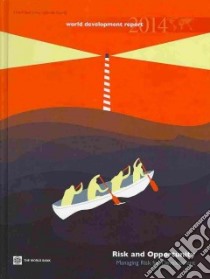Risk and Opportunity - 9780821399644
Un libro in lingua di World Bank (COR) Kim Jim Yong (FRW) edito da World Bank, 2013
- € 52.80
- Il prezzo è variabile in funzione del cambio della valuta d’origine
The past 25 years have witnessed unprecedented changes around the world—many of them for the better. Across the continents, many countries have embarked on a path of international integration, economic reform, technological modernization, and democratic participation. As a result, economies that had been stagnant for decades are growing, people whose families had suffered deprivation for generations are escaping poverty, and hundreds of millions are enjoying the benefits of improved living standards and scientific and cultural sharing across nations. As the world changes, a host of opportunities arise constantly. With them, however, appear old and new risks, from the possibility of job loss and disease to the potential for social unrest and environmental damage. If ignored, these risks can turn into crises that reverse hard-won gains and endanger the social and economic reforms that produced these gains. The World Development Report 2014 (WDR 2014), Risk and Opportunity: Managing Risk for Development, contends that the solution is not to reject change in order to avoid risk but to prepare for the opportunities and risks that change entails. Managing risks responsibly and effectively has the potential to bring about security and a means of progress for people in developing countries and beyond. Although individuals’ own efforts, initiative, and responsibility are essential for managing risk, their success will be limited without a supportive social environment—especially when risks are large or systemic in nature. The WDR 2014 argues that people can successfully confront risks that are beyond their means by sharing their risk management with others. This can be done through naturally occurring social and economic systems that enable people to overcome the obstacles that individuals and groups face, including lack of resources and information, cognitive and behavioral failures, missing markets and public goods, and social externalities and exclusion. These systems—from the household and the community to the state and the international community—have the potential to support people’s risk management in different yet complementary ways. The Report focuses on some of the most pressing questions policy makers are asking. What role should the state take in helping people manage risks? When should this role consist of direct interventions, and when should it consist of providing an enabling environment? How can governments improve their own risk management, and what happens when they fail or lack capacity, as in many fragile and conflict-affected states? Through what mechanisms can risk management be mainstreamed into the development agenda? And how can collective action failures to manage systemic risks be addressed, especially those with irreversible consequences? The WDR 2014 provides policy makers with insights and recommendations to address these difficult questions. It should serve to guide the dialogue, operations, and contributions from key development actors—from civil society and national governments to the donor community and international development organizations.
Informazioni bibliografiche
- Titolo del Libro in lingua: Risk and Opportunity
- Sottotitolo: Managing Risk for Development
- Lingua: English
- Autori : World Bank (COR) Kim Jim Yong (FRW)
- Editore: World Bank
- Collana: World Bank (Hardcover)
- Data di Pubblicazione: 09 Ottobre '13
- Genere: BUSINESS and ECONOMICS
- Pagine: 343
- EAN-13: 9780821399644


